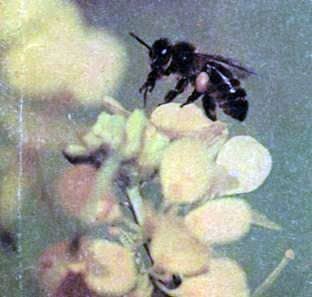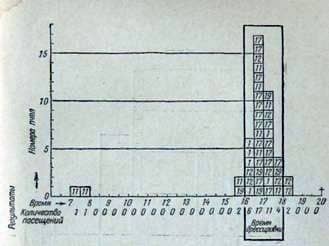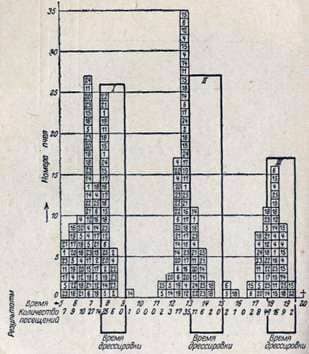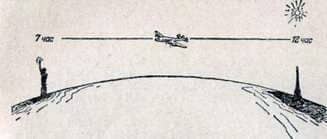Memory for the time of bees

Each of us from our own experience knows what a sense of time. It can be relied on to a greater or lesser extent, but there is no person for whom it is completely absent.
A dog or a parrot well remembers the hour of joyful events for them, if these events are regularly repeated. It is difficult to speculate whether there can be something like this in insects, since their organism is arranged quite differently from ours. It can only be decided by experience.
We’ll arrange an artificial bribe on a table set at will, luring the bees there for a cup of sugar syrup. Insects that visit this trough, number, so that you can recognize “in person” each individual bee. We will not feed the bees throughout the day, but only a certain time, for example, from 4 to 6 hours in the afternoon. We will do the same in the following days. The scouts of a numbered group who visit the feeder before 4 and after 6 o’clock in the afternoon, find it empty and return home with nothing.
After a few days, during which the feeding was done only from 4 to 6 o’clock in the afternoon, a control experiment is conducted. This time the feed does not feed at all, the cup remains empty also from 4 to 6 o’clock in the afternoon. From 6 o’clock in the morning till 8 o’clock in the evening near her there is an observer on duty who marks every bee that has flown to the cup. This is a very boring job, because in our experience, out of six bees, who visited the cup in the days preceding the experiment, only one bee No. 11 appeared from 6:00 am to half-past four on the day to check the feeder. She flew in between seven and half past eight in the morning and soon appeared again. For the rest of the time, the absolute manners reigned on the manger.
However, as soon as the time of ordinary feeding has come, the matter has gone more vividly. In two hours between 4 and 6 o’clock

Fig. 97. Testing the ability of bees to memorize time. Several numbered bees daily received sugar syrup on the trough from 46 to 18 hours. On the day of the control experiment (July 20, 1927), the feeder was empty all day – and the usual time for training. The bottom horizontal line is the hours of the day. Over each half-hour interval, the numbers of bees that were flying in this period to the feeding trough are marked. Placed above each other squares with the same numbers mean that during this period, the same bee several times flew from the hive, to the trough, to carry out reconnaissance.
Contrary to expectations, the experiment was a success. Its results are clearly shown in the diagram. The bottom horizontal line postpones the time from 6 am to 8 pm. The time of training (from 4 to 6 hours in the days preceding the experiment) is framed. The entire period of time is divided by thin dashes for half-hour intervals, above each one you can find the circled numbers of all the bees that visited the trough in the given half-hour, and count their number.
This experience was repeated many times with other bees and at different times of the day. The outcome of each of them did not leave any doubt that bees after a few days surprisingly accurately remember any hour of feeding.
The successful results of these experiments have prompted us to put a more difficult test on the ability of bees to feel the time. The result of the new experience surpassed all expectations. She also trained for two, three and even five different periods of feeding during the day.

Fig. 98. The result of three-time training. The duration of training is six days. On the day of the control experiment (August 13, 1928), despite the fact that the feeding troughs remained empty all day, 19 of all 19 numbered bees flew in, and at that time, which is noted in the figure.
In Fig. 98 shows an example of one such three-time training. The punctuality of the bees in this case suffered somewhat: they flew to the feeder too early. This phenomenon is often observed also during training at one time of day. And it’s not entirely impractical. It is better to come too early than too late, since there are a lot of hungry mouths in nature, ready to pull food from under the nose of others. Thus, bees are not so easy to conduct. And if you remember that on August 13, from morning to evening, they did not find a drop of sugar syrup on the test table, then one look at Fig. 98 will clearly show that three-fold feeding at certain times during the six days preceding the experience could not but affect them.
There is quite a natural question: where are the bees watch? Not in the stomach, which in the time habitual for feeding begins to pulsate and forces it to fly out of the hive to the feeder? This can not be because the time of the appearance of food in the trough – not the time of eating in the usual sense of the word. The bee flies to the trough not in order to get enough, but in order to collect a stock of feed and take it to the hive. In addition, she spent the whole day on honey-filled honeycombs and she had enough to pull the proboscis to satisfy hunger at any time.
This assumption is completely refuted by the following experiment: we will offer a group of bees to take sugar syrup for many days, from morning till night, which is provided at certain hours of the day to them in abundance or which is more sweet in these hours than during the rest of the time. The bees collect it without interruption, their stomach never remains empty, and yet on the days of observation at the usual “best harvesting time” they come with enormous zeal to the now empty feeders. But, perhaps, the bee, like a traveler, observes the position of the sun? This, perhaps, can be believed, as it became known that under certain circumstances the bees closely monitor the position of the sun in the sky. Whether the position of the sun is of decisive importance for the orientation of bees in time, we ourselves can not find out and must verify this with the help of experience.
You can move the family to a dark room so that the flight area of its bees is limited to four walls of this room. If in this “prison” constantly keep the temperature from 25 to 28 њ C, illuminate it with electric lamps and in abundance supply bees with food on an artificial feeding trough, then a small family even in such unnatural conditions can be healthy for many years. She does not feel the change of seasons and grows in her honeycomb brood both in summer and in winter. With uniform illumination, there is no way for bees to determine the time by the position of the sun or by the degree of illumination. Despite this, training for a while is possible in such conditions, if the bees in this room are fed at certain hours. Using artificial lighting,
The experience of training bees for more than 24 hours, the length of time is not possible. It is possible to offer food for weeks at intervals of 19 hours (this does not present any difficulties in a dark room with uniform lighting) – a period of 19 hours the bees do not perceive. In another experiment, the bees were fed for a long time every 48 hours. After that for two days they flew for syrup every 24 hours. It seems that bees remember not a period of time between feedings, but a certain time of the day during which they are given food.
Obviously, there are two possibilities: either bees are guided by daily periodic influences that are inaccessible to our perception, or they have “internal clocks” associated with metabolism in their bodies. If this is the case, then all the failures of training for a 19- or 48-hour rhythm can be explained only by the fact that bees are closely related to the daily cycle in their way of life and, therefore, do not switch to another periodicity.

Fig. 99. Transoceanic experience for testing the ability of bees to determine the time of day. Bees trained in Paris to visit the trough at certain times were taken by plane to New York and tested there.
A clear explanation was given by the transoceanic experience. In Munich, two completely identical dismountable dark chambers were made and one of them was forwarded to Paris and the other to New York. When in Paris noon (12 o’clock in the afternoon) and the sun is at its zenith, the inhabitants of New York still only 7 o’clock in the morning and they see the morning sun. If the bees are guided by the local position of the sun, which they perceive even in a dark chamber due to the rays penetrating there or in some other way unknown to us, then after training for some specific time in Paris and a rapid movement across the ocean to New York, they should appear on the bird feeder New York time. But this does not happen. Trained in a dark Parisian chamber to visit the trough at a certain time and transported by plane to New York, Little travelers and they flew to the trough in Parisian time. So, bees are really able to determine the time of day for some “internal clock”.
Very expressively they show us this ability and in another way. The bee-scout of a family in a swarm state, after finding a suitable dwelling, inform other bees of his whereabouts with the help of dances, and they indicate the direction to the flight goal by the position of the sun. Sometimes they stay home for many hours and, repeating the dances, again and again pay attention to the possibility of bees to organize a new nest.
While in the hive, they can not notice that the sun has meanwhile moved in the sky. Despite this, in their long dances they change the angle relative to the direction of gravity in exact accordance with how the angle between the direction to the object of their flight and the direction to the sun changes during this time. They did this even when they were taken to a basement in a closed hive, from which they could not see either the sun or the sky. So bees give us new evidence of having an “internal clock” and at the same time the consistency of their actions with the daily rhythm of the sun.
The ability to feel time is necessary for bees – this is confirmed by the example just cited. After all, and for a general orientation in space, the sun can be used as a compass only if it is possible to take into account the time of day. So from this point of view, the training of bees on the feeder, filled at certain times with syrup, is not at all an unnatural experience, as it may seem to some. Many flowers invite their visitors “to the table” also by the hour. They allocate flower pollen and nectar only at certain times of the day.
Often the selection of nectar, although it lasts a whole day, but at some hours is more abundant. In many plant species, the “best time” is in the morning, others in the middle of the day, and in some in the afternoon, and each plant species usually displays a constant attitude in this respect. And since bees are also extremely constant in relation to visiting flowers, that is, each of them visits flowers of only one species during the day, this means that all groups of pickers at a certain time are working very hard, and the rest of the time they are inactive. Unemployed bees are forced to stay at home, because the outside world is full of dangers.
The bee pickers actually stay in the beehive when the sources from which they take bribes temporarily stop giving it. Only individual scouts fly out to check if bribes have opened. If such a scout discovers that the flowers are filled with nectar again, she dances on the honeycomb in the same way as when a bribe is opened for the first time, and again calls on her entire group of pickers to go to the meadow. With occasional breaks on a bribe, scouts fly for a longer time, so as not to miss the moment when their group of bees can use the noteworthy newly discovered bribes. If the time of bribe is strictly limited, bee-scouts quickly adapt their flights to these hours of the day.
In the absence of time, the whole group of collectors is usually chosen from the restless hubbub of the “dance floor” and sleeps in some secluded corner on the edge of the honeycomb, and their internal clocks continue to go on their own. When the time comes for a bribe, all this society, seemingly asleep, awakens to life, as from an alarm bell. The bees slowly slid from all sides to the site of the honeycomb where dance takes place and where they have the opportunity to meet the first scout who returned home from a successful flight. Sometimes they are immediately taken for work on their own instinctive motivation.
Memory for the time of bees
